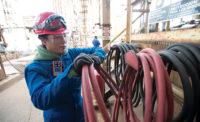You know how important it is for workers to use gas detectors in potentially hazardous areas. You are also really good about making sure that your people are trained to use them properly. You probably even have the dataloggers in your gas detectors activated. That’s because you understand how important it is to record this information.
Maybe you view the data or download it to your computer every now and then. You may look for things that stand out: a session high alarm here, a time-weighted average alarm there. You make a mental note and take action if necessary. After all, your gas detector just told you some important information. But is that all?
Common uses of data
If you are like most people, you probably just file the information away and hope you never need it. You would only retrieve it if an “incident” happened and you needed to investigate. Worse, you would have to retrieve it for an external agency investigation. Either way, you have your information. You feel like you have your bases covered.
If you are adventurous and concerned about the details, you may chart or graph information about a gas detector or session. You may even compare some sessions for context.
This is the extent to which most people use the data collected by their gas detectors. This is how most people listen to what their detectors have to say.
A more proactive approach
Have you ever thought about analyzing your data? If you’re in a reactive position, the only time you analyze data is after an incident. A more proactive approach would be to analyze the data on a regular basis. Doing so allows you to see potentially dangerous trends in both exposure and gas detector usage. You can use the data that you are collecting right now to prevent some incidents from occurring in the future.
Imagine having the ability to see how gas detectors are being used, not only at the moment, but over time. Imagine having this visibility across you entire gas detector fleet. Imagine being able to distill the information down to specific gas detectors or individual users when necessary.
Usage data
Do you know how many gas detectors in your fleet went into alarm last month? Do you know if any of them were turned off while in alarm? If so, do you know who was using them? Do you know if some users do this more often than others? Can your gas detectors tell you this?
What about lengthy high alarms? You may see the individual occurrences after the fact. But do you know which users experience high alarms most often? If so, these users would benefit from training on the correct response to high alarms. That way, they are not staying in dangerous areas longer than they should. On the other hand, you may find that the reason for this was not so obvious. Perhaps it has more to do with a process or procedure. Whatever the cause, you cannot improve the situation if you are not aware of it.
Maintenance data
Let’s think about you calibration and bump testing records for a moment. I’m sure you have them. You may keep track on a piece of paper or a spreadsheet. If you use a docking or calibration station, they are recorded automatically. But how often do you review those records? Do you know what the data can tell you?
Do you know if a gas detector was used without being bump tested or was overdue for calibration? Do you know how often this occurs and who uses gas detectors in this condition? What if an incident occurs? Worse yet, what if a gas detector that is overdue for calibration or bump testing contributes to the incident? How would it feel to know that the person using the gas detector was not adequately protected?
Putting it all together
If you had the ability to interweave datalogged information with your calibration and bmp test records, you would gain real insight into what was going on with your gas detectors. Ultimately, you would know the level of risk your team was facing every day. Perhaps there is someone on your staff who consistently uses a gas detector without bump testing it first. Maybe this person has no regard for the procedure or for personal safety. Or maybe the person doesn’t have the proper tools to perform bump tests. The point is that you have to know about a problem first before you can diagnose and fix it.
Your people aren’t likely to tell you if they are not following proper procedures. They aren’t going to tell you if a certain requirement of their job puts them at increased risk. But your gas detectors can tell you if you are willing to listen. What are your gas detectors trying to tell you?

